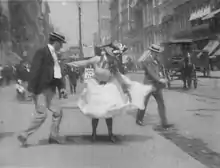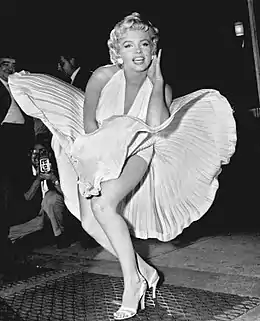What Happened on Twenty-third Street, New York City
What Happened on Twenty-third Street, New York City is a 1901 American short film.
| What Happened on Twenty-third Street, New York City | |
|---|---|
 A screenshot from the film | |
| Directed by | George S. Fleming Edwin S. Porter |
| Starring | A. C. Abadie Florence Georgie |
| Cinematography | Edwin S. Porter |
Release date |
|
Running time | 77 seconds |
| Country | United States |
Plot
The 77 second film depicts a woman, escorted by a man, walking over a grate. The hot air lifts her skirt, she laughs and they walk on.
Comparisons

In 2001, Rosemary Hanes and Brian Taves compared the sequence to the iconic image of Marilyn Monroe in a white dress in the 1955 film The Seven Year Itch, writing "With The Seven Year Itch (1955, FGB 0012-0023), the image of Marilyn Monroe's thighs exposed under her billowing skirt entered American popular culture. The Library's motion picture and broadcasting collections provide the opportunity to document not only how women's roles and their depictions have changed throughout the past hundred years, but also how much has remained the same."[1]
Tom Gunning makes another observation, contrasting the two events as narrative devices writing "The act of display [in What Happened...] is both climax and resolution here and does not lead to a series of incidents or the creation of characters with discernible traits. While the similar lifting of Marilyn Monroe's skirt in The Seven Year Itch also provides a moment of spectacle, it simultaneously creates character traits that explain later narrative actions."[2][3]
See also
- Promotional film poster of The Woman in Red (1984 film)
References
- Rosemary Hanes with Brian Taves. "Moving Image Section--Motion Picture, Broadcasting and Recorded Sound Division" The Library of Congress. Retrieved 5 January 2011. From a chapter in American Women: A Library of Congress Guide for the Study of Women's History and Culture in the United States, Library of Congress, 2001.
- Lee Grieveson, Peter Krämer. The silent cinema reader (2004) ISBN 0-415-25283-0, ISBN 0-415-25284-9, Tom Gunning "The Cinema of Attractions" p.46. Retrieved 5 January 2011.
- Richard Abel. Silent film (1996) ISBN 0-485-30076-1, Tom Gunning '"Now You See It, Now You Don't": The Temporality of the Cinema of Attractions' p.78. Retrieved 5 January 2011.
External links
| Wikimedia Commons has media related to What Happened on Twenty-third Street, New York City. |
- What Happened on Twenty-third Street, New York City at IMDb
- What Happened on Twenty-third Street, New York City on YouTube
- The short film What Happened on Twenty-third Street, New York City is available for free download at the Internet Archive